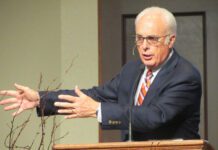A few years ago, I was attending a preaching conference with the theme of Creativity in Preaching. Some of the most respected names from the field of preaching were keynote speakers and teachers. Among them was Haddon Robinson. I had long desired to meet Dr. Robinson, so I eagerly attended his session on “Imagination in Preaching.” As he shared, I found myself thoroughly engaged in his presentation. Although he lectured for almost an hour, there was one line that resonated in my thoughts. The line was simply, “If you don’t feel literature, then you aren’t really reading.” He was stressing the idea of actually becoming a part of the narrative as you read it. I was so intrigued by this thought that I chose not to stand in the line to meet him after his presentation. Instead, I took a stroll around the church premises and pondered that one line.
Interestingly, over the years I had stressed this same idea many times to my students. Now that I had heard Robinson endorse the idea, I felt particularly vindicated. Too often, as expositors, we are so engrossed in discovering the spiritual bottom line of a passage that we miss the true heart of it. This is particularly true of parabolic or narrative literature. We tend to practice what I call “guessegesis” rather then pure exegesis. If we see a spiritual word (like “love”) or a phrase describing a sin (like “and he lay with her…”), we eagerly grab hold of it as though it is the Holy Grail of the passage. Oftentimes, these spiritual or “sinful” words and phrases are, in actuality, playing a supporting role. The true “star” of the story is completely missed because of our quest for obvious spiritual truth.
This brings me back to Robinson’s notion of feeling the literature. I am now convinced, more than ever, that a significant goal of preaching biblical narrative is to help the listeners “feel the story.” By feeling it, I mean they connect with it emotionally, within their senses and in their spirits. In actuality, they are lead to discover the meaning and implications for themselves once they are emotionally and spiritually connected to the story.
I have had the privilege of serving as a transitional pastor for a number of years now. I have served in churches with different approaches to worship and certainly differences in listeners. I have preached in the most traditional and staid pulpits. I have preached in blended services. I have also preached in what one might consider the most radical of contemporary services. I have walked into all of these pulpits having read countless articles and chapters on “the postmodern listener.” I have been duly warned that if I do not understand certain traits of these “different” people then my preaching will likely be in vain.
Please understand, I am not devaluing the information provided by scholars of postmodernity. I do believe we must take time to study cultural and social realities of our modern world. But I have wondered many times if the Lord Jesus, if He were preaching in this century, would change his approach in consideration of the postmodern audience.
What I have discovered is that a little imagination (to use Robinson’s word) is really all that is needed to connect the text to any listener. Allow me to suggest two ways to accomplish this:
1. Become the proverbial “fly on the wall”
What I mean by this is to change the way you currently read biblical narrative. Rather than search for what seems to be the obvious spiritual truth, envision the story in your mind as you read it. I constantly tell my students that I rarely prepare sermons in the study. I almost always prepare them in the sanctuary. While this may seem radical for some of you, let me ask what better place to see my listeners? People tend to always sit in the same place each Sunday. Therefore, I can see each one of them as I process the implications of the selected text for their lives.
When I am in the sanctuary, I read over the narrative countless times. I create in my mind the actual scene. I imagine I am walking with the Lord observing His actions and hearing His words. The implications often flow so quickly that I can’t jot them down fast enough. I become a part of the story. Most of us know that we can tell a story so much better, with vividness and flair, if we were actually a part of the event.
I often shock my students by telling them to avoid the commentaries until after the “fly on the wall” process. If we read commentaries initially, then commentators will guide our thinking. Too often, they point us to the obvious spiritual words. Rarely do commentators investigate a narrative from the “fly on the wall” perspective. Commentaries are best used, in my opinion, as sources of confirmation rather than directors to truth. We want to turn to them for verification of our findings and to provide insights we may have missed or can’t discern from a cursory reading of the text. They will help us to see how the obvious “spiritual” words fit the narrative. So, become a fly on the wall and avoid those commentaries at first. This way you will begin to connect with the story. You will become a part of it.
2. Bring the biblical story into the 21st century
Many people love college and professional football. Most of us know what it is like to attend an actual game. As we drive into the stadium parking lot, we struggle with the lines of traffic and finding a parking space. As we head toward the stadium, we walk with people who typically are dressed in jerseys and colors that represent their team. We pass by tailgaters cooking burgers and hot dogs. We are accosted by scalpers who want us to buy a ticket. We pass souvenir stands or individuals wanting us to purchase stuff related to the home team. As we enter the stadium, we hand our tickets to ticket-takers who scan them and give them back to us. Then, if we are carrying bags, we are searched to ensure we are not terrorists. We then look for our seats and wait for the kickoff.
Suppose we did all these things on a particular Saturday but no teams showed up to play. There we are with our jerseys, hot dogs, and enthusiasm; but no players actually play a game. What would we do in such a scenario? Obviously, we would begin to search for answers to this injustice! We would ask people sitting near us, those we don’t even know, “What’s the deal?” We would check our tickets for date and time. We would call the ushers over and murmur to them. We would virtually “curse” the situation. Everything we have seen, experienced, and had been lead to believe said to us, “Game here today!” We would lose our trust in the entire football system.
As you read the above, you saw that scene in your mind. There is no way you could not have. Our minds think in pictures. You may have been at a different stadium rooting for a different team than I envisioned, but you no doubt created the scene. You even “felt” the scene. You felt the injustice. You probably remembered and sensed the smell of cooking burgers. Even while I am typing this, my mouth is watering for a Wendy’s double with cheese!
This reveals the power in bringing the biblical story into the 21st century. Now consider the following narrative from the Gospel of Mark, Chapter 11:
The next day as they were leaving Bethany, Jesus was hungry. Seeing in the distance a fig tree in leaf, he went to find out if it had any fruit. When he reached it, he found nothing but leaves, because it was not the season for figs. Then he said to the tree, “May no one ever eat fruit from you again.” And his disciples heard him say it. On reaching Jerusalem, Jesus entered the temple area and began driving out those who were buying and selling there. He overturned the tables of the moneychangers and the benches of those selling doves, and would not allow anyone to carry merchandise through the temple courts. And as he taught them, he said, “Is it not written:
“‘My house will be called a house of prayer for all nations’? But you have made it ‘a den of robbers.'” The chief priests and the teachers of the law heard this and began looking for a way to kill him, for they feared him, because the whole crowd was amazed at his teaching. When evening came, they went out of the city.
In the morning, as they went along, they saw the fig tree withered from the roots. Peter remembered and said to Jesus, “Rabbi, look! The fig tree you cursed has withered!” “Have faith in God,” Jesus answered. “I tell you the truth, if anyone says to this mountain, ‘Go, throw yourself into the sea,’ and does not doubt in his heart but believes that what he says will happen, it will be done for him. Therefore I tell you, whatever you ask for in prayer, believe that you have received it, and it will be yours.
In this passage, Jesus approached a tree and a temple. Both appeared to be places of nourishment: one physical, one spiritual. He found both to be fraudulent. Everything about the tree, from a distance said, “Figs here!” Everything about the Temple and the activities surrounding it, from a distance said, “God here!” But upon close investigation, both were fraudulent. Both angered the Lord.
Can you see the connection of this story to the football analogy? Can you see how telling the story of the fraudulent football game, which caused you to feel anger and injustice (and even smell cooking burgers), can be used as a creative and imaginative lead in to the story in Mark 11?
The implication for the modern audience is simply this: Those who are truly Christians will not only look the part, but will exemplify the power reserved for those who live in faith. They will be powerful examples of sacrifice and prominent producers of spiritual fruit. In other words, they will not be fraudulent.
So here’s the takeaway. I contend that any person from any culture, whether young or old, male or female, modern or postmodern can easily relate to this approach to biblical narrative. Why? Because they can feel it in their hearts, minds, and spirits. I trust you can see the value of this approach.













